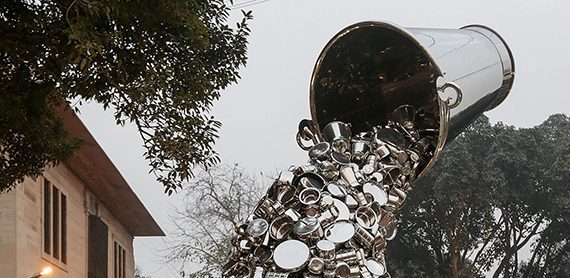Subodh Gupta’s midcareer retrospective could only have been realised in India; his recent largescale installations would be much more difficult and expensive to fabricate without the work of his local studio staff and resources. But more than that, his more personal, rurally inspired early works are also more approachable and appealing in the context of the ‘real’ (at the same time surreal) soil of the country. In New Delhi, which provides a domestic perspective from which to read the show, distracting discussions about nationalism and cultural symbolism are neutralised: here we can pay attention to the artworks.
Curated by Germano Celant, the show occupies both the new and the old buildings of the National Gallery of Modern Art. The huge mirrorpolished steel tree Dada (2010–4) located in the centre of the garden is visible from the street; in the evening, the tree reflects the lights of New Delhi through the city’s damp and foul air.
A constellation of Gupta’s huge installations – many now familiar from international exhibitions – have been arranged in the museum’s spectacular modern extension, together with recent large paintings of dishes carrying leftover food, and well-known sculptures from earlier in his career. The site-specific Thōsa Pani (Solid Water, 2013) is a huge curly structure made of stainless steel kitchenware that flushes from the wall of the museum towards the centre of the building, like a typical South Asian flood in the rainy season. It sets up a conversation with its neighbour, the suspended wooden ship of All in the Same Boat (2012–3), which is filled with pots and pans and spinning ceiling fans, reminiscent of news footage of people loading small boats after a flood. Saving everything one owns and values in a single carefully packed, transportable unit – literally ‘everything is inside’ – is a recurring image in Gupta’s works; here at the National Gallery, which was built by workers who came to the city with their packaged possessions and carry their lunches in stainless-steel lunchboxes, these installations and sculptures seem like monuments to the lives of ordinary people in India.
The old building of the National Gallery, the historic Jaipur House, is filled with sculptures, early video, performance works and painting. Gobar (cow dung), kitchenware and patlas (low wooden seats) are the objects Gupta chooses to translate the daily life of rural India into ritual practice for modern life. The former lobby space houses a reconstruction of My Mother and Me (1997), a cylindrical architectural structure composed of layered cowpats. Used as fuel, architectural material, floor covering and even articles of worship, gobar is the materialised symbol of traditional India and still plays an important role today. Gupta buried himself in it to purify his body and soul in Pure (1999) and used it to paint handmade paper in Bihari (1999; Bihar is Gupta’s hometown). His material exploration extends further; in workers’ sacks he finds the transfer from heaviness to lightness; via brass he makes mundane or abandoned objects monumental and sacred; through marble and stainless steel, the most popular materials in modern India, he draws the picture of its people’s desires and their materialised realisation.
If the monumental works installed in the garden and the modern extension cement Gupta’s international position and achievements as India’s leading contemporary artist, the Jaipur House is more like a journey back home, and touching for it.
Subodh Gupta, Everything Is Inside, National Gallery of Modern Art, New Delhi, 17 January – 16 March 2014
Published in the May 2014 issue of ArtReview Asia
